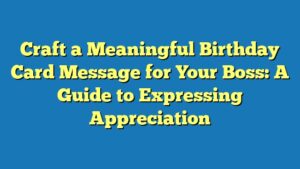Best wishes in new job messages are expressions of congratulations and support sent to individuals starting new employment. Example: “Congratulations on your new role! Wishing you all the best in your journey.”
These messages foster goodwill, boost morale, and acknowledge the significance of career transitions. Historically, the invention of email and social media platforms facilitated the widespread sharing of these messages.
In this article, we explore the nuances of best wishes in new job messages, including their composition, etiquette, and impact on workplace relationships.
Best Wishes in New Job Messages
Best wishes in new job messages are crucial for fostering a positive and supportive workplace culture. They acknowledge the hard work and dedication of individuals embarking on new career paths.
- Congratulatory
- Supportive
- Motivational
- Encouraging
- Thoughtful
- Respectful
- Professional
- Timely
- Personalized
- Appropriate
These messages can take various forms, such as emails, handwritten notes, or social media posts. They often include expressions of confidence in the individual’s abilities, well wishes for their success, and offers of support. By sending thoughtful and heartfelt best wishes, colleagues and organizations can contribute to a positive onboarding experience and create a welcoming work environment.
Congratulatory
Congratulatory messages are a crucial component of best wishes in new job messages. They serve to acknowledge and celebrate the recipient’s achievement and express positive regard for their career advancement.
The congratulatory aspect of these messages is essential because it conveys a sense of recognition and appreciation for the individual’s hard work, dedication, and accomplishments. It helps to create a positive and supportive atmosphere, fostering a sense of camaraderie and goodwill within the workplace.
In practice, congratulatory messages often include phrases such as “Congratulations on your new role!” or “Best wishes as you embark on this exciting new chapter in your career.” They may also express confidence in the recipient’s abilities and offer words of encouragement for their future success.
Understanding the connection between congratulatory messages and best wishes in new job messages is important for crafting effective and meaningful communications. By incorporating genuine and heartfelt congratulations, these messages can make a significant positive impact on the recipient and contribute to a positive workplace culture.
Supportive
Supportive messages are essential in new job messages because they provide encouragement, reassurance, and a sense of belonging to individuals starting a new chapter in their careers.
Support can manifest in various ways within these messages. It can be expressed through words of encouragement, such as “You’ve got this!” or “I believe in your abilities.” Supportive messages can also offer practical assistance, such as “Let me know if you need anything” or “I’m here to help in any way I can.” By providing support, colleagues and organizations can help new employees feel welcomed, valued, and confident in their new roles.
Understanding the importance of supportive messages in new job messages is crucial for creating a positive and inclusive work environment. These messages can make a significant difference in the onboarding experience of new employees and contribute to their long-term success within the organization.
Motivational
Motivational messages are a critical component of best wishes in new job messages because they provide encouragement, inspiration, and a boost of confidence to individuals embarking on new career paths.
Motivational messages can take various forms, such as words of encouragement, quotes from successful individuals, or anecdotes about overcoming challenges. They can also focus on the recipient’s strengths, potential, and aspirations. By providing motivation, colleagues and organizations can help new employees stay positive, focused, and driven as they navigate the challenges and opportunities of their new roles.
Understanding the connection between motivational messages and best wishes in new job messages is crucial for crafting effective and meaningful communications. These messages can make a significant difference in the onboarding experience of new employees and contribute to their long-term success within the organization.
Encouraging
Encouraging messages are a vital part of best wishes in new job messages as they provide motivation, reassurance, and a sense of belief in the recipient’s abilities.
Encouraging messages can take many forms, such as expressing confidence in the recipient’s skills and experience, reminding them of their past accomplishments, or sharing stories of others who have succeeded in similar roles. They can also focus on the positive impact the recipient can make in their new position and the value they bring to the organization.
Understanding the importance of encouraging messages in new job messages is essential for crafting effective and meaningful communications. These messages can make a significant difference in the onboarding experience of new employees and contribute to their long-term success within the organization.
Thoughtful
Thoughtful messages are essential in new job messages because they convey a genuine interest in the recipient’s success and well-being. They demonstrate that the sender has taken the time to consider the recipient’s individual journey and aspirations.
Thoughtful messages can take many forms, such as acknowledging the recipient’s unique skills and experiences, expressing excitement about their potential contributions to the organization, or offering specific advice or support tailored to their new role. They can also include personal touches, such as a shared memory or anecdote, that show the sender has taken the time to connect with the recipient on a meaningful level.
Understanding the significance of thoughtful messages in new job messages is crucial for crafting effective and meaningful communications. These messages can make a significant difference in the onboarding experience of new employees and contribute to their long-term success within the organization.
Respectful
Respectful messages are essential in new job messages because they convey a sense of consideration and value for the recipient. They demonstrate that the sender understands the importance of the recipient’s new role and the challenges they may face.
Respectful messages can take many forms, such as acknowledging the recipient’s experience and qualifications, expressing appreciation for their decision to join the organization, or offering support and guidance without being condescending. They can also include specific examples of how the recipient’s skills and experience will be valuable to the team.
Understanding the significance of respectful messages in new job messages is crucial for crafting effective and meaningful communications. These messages can make a significant difference in the onboarding experience of new employees and contribute to their long-term success within the organization.
Professional
Professionalism is a crucial aspect of best wishes in new job messages as it sets the tone for a respectful and supportive workplace relationship.
-
Appropriate Language:
Using formal language and avoiding slang or colloquialisms demonstrates respect for the recipient and the significance of their new role. -
Focus on Accomplishments:
Highlighting the recipient’s accomplishments and skills in the message shows that you value their experience and expertise. -
Respectful Tone:
Maintaining a polite and respectful tone throughout the message conveys that you value the recipient’s time and consideration. -
Conciseness:
Keeping the message concise while conveying your well wishes shows that you respect the recipient’s busy schedule.
By adhering to these professional standards, best wishes in new job messages can effectively convey support, encouragement, and respect, contributing to a positive and productive work environment.
Timely
In the context of best wishes in new job messages, “Timely” refers to the significance of sending well-wishes at an appropriate moment. Sending messages promptly demonstrates consideration for the recipient, acknowledges the importance of their new role, and contributes to a positive onboarding experience.
- Promptness: Sending messages soon after the news of the new job becomes known shows that you are aware of and responsive to the recipient’s career milestone.
- Alignment with Events: Sending messages on or around the first day of work demonstrates support and excitement for the recipient as they embark on this new chapter.
- Respect for Transitions: Allowing some time to pass before sending messages can provide the recipient with space to settle into their new role before receiving an influx of well-wishes.
- Consideration for Time Zones: If the recipient is located in a different time zone, sending messages during their business hours shows respect for their schedule and avoids potential interruptions.
Overall, sending timely best wishes in new job messages conveys thoughtfulness, support, and a genuine desire to celebrate the recipient’s success. It contributes to a welcoming and encouraging work environment, fostering positive relationships and setting the tone for a successful transition into the new role.
Personalized
In the context of best wishes in new job messages, “Personalized” refers to the tailoring of messages to the specific recipient, acknowledging their unique qualities, accomplishments, and aspirations. This personalization adds a thoughtful touch that enhances the impact and meaningfulness of the message.
Personalized messages demonstrate that the sender has taken the time to consider the recipient’s individual journey and career goals. By incorporating specific details, such as the recipient’s name, previous experience, or shared connections, the message becomes more relevant and engaging. This personalization creates a stronger connection between the sender and recipient, fostering a sense of camaraderie and support.
Practical applications of personalized messages include highlighting the recipient’s skills and experience that are particularly relevant to the new role, expressing confidence in their ability to succeed, or offering specific support or guidance tailored to their needs. By personalizing the message, the sender shows that they have invested time and effort in crafting a thoughtful and meaningful communication.
In summary, personalized best wishes in new job messages are crucial for building strong relationships, fostering a positive work environment, and demonstrating genuine support for the recipient. They allow the sender to convey their well-wishes in a way that is both meaningful and motivating, contributing to the recipient’s successful transition into their new role.
Appropriate
In the context of best wishes in new job messages, “Appropriate” refers to the suitability and relevance of the message to the recipient and the occasion. Sending appropriate messages demonstrates respect for the recipient’s time and attention, and contributes to a positive and professional work environment.
Appropriate messages are tailored to the recipient’s specific role, industry, and career level. They avoid overly formal or informal language, and strike a balance between being congratulatory and professional. For example, a message to a newly appointed CEO would likely be more formal and focused on their leadership qualities, while a message to a junior-level employee could be more casual and focus on their enthusiasm and potential.
Understanding the importance of appropriateness in best wishes in new job messages is crucial for crafting effective and meaningful communications. By sending appropriate messages, individuals can show that they have taken the time to consider the recipient and the context of the message. This contributes to a positive and supportive work environment, and helps to build strong relationships between colleagues.
In summary, appropriateness is a critical component of best wishes in new job messages as it ensures that the message is relevant, respectful, and appropriate for the occasion. By adhering to these standards, individuals can effectively convey their support and well wishes to colleagues and contribute to a positive and professional workplace culture.
Frequently Asked Questions about Best Wishes in New Job Messages
This FAQ section addresses common questions and misconceptions about best wishes in new job messages, providing clear and informative answers to enhance understanding and guide effective communication in the workplace.
Question 1: What is the purpose of best wishes in new job messages?
Answer: Best wishes in new job messages aim to congratulate, support, and motivate individuals starting new career paths. They foster goodwill, acknowledge career transitions, and contribute to a positive work environment.
Question 2: What are the key elements of an effective best wishes in new job message?
Answer: Effective messages are congratulatory, supportive, motivational, encouraging, thoughtful, respectful, professional, timely, personalized, and appropriate.
Question 3: Why is it important to send timely best wishes in new job messages?
Answer: Sending timely messages demonstrates consideration and acknowledges the significance of the recipient’s new role, contributing to a positive onboarding experience.
Question 4: How can I personalize my best wishes in new job messages?
Answer: Personalize messages by incorporating specific details about the recipient, such as their name, previous experience, or shared connections. Highlight their relevant skills and express confidence in their success.
Question 5: What is the appropriate tone for best wishes in new job messages?
Answer: The tone should be professional, respectful, and supportive. Avoid overly formal or informal language, and tailor the message to the recipient’s role and career level.
Question 6: How can best wishes in new job messages contribute to a positive workplace culture?
Answer: These messages foster a sense of camaraderie, support, and recognition. They create a welcoming and encouraging work environment, contributing to employee morale and job satisfaction.
In summary, best wishes in new job messages are a valuable tool for building relationships, demonstrating support, and enhancing workplace culture. By understanding the key elements and following the guidelines outlined in this FAQ section, individuals can effectively convey their well wishes and contribute to a positive and supportive work environment.
Transition: Best wishes in new job messages are an important aspect of workplace communication, but they are just one part of a successful onboarding process. In the next section, we will explore additional strategies for welcoming and supporting new employees.
Tips for Sending Best Wishes in New Job Messages
To effectively convey your support and well wishes in new job messages, consider these practical tips:
Tip 1: Keep it Congratulatory: Express your sincere congratulations on the recipient’s new role, acknowledging their hard work and achievements.
Tip 2: Offer Support: Let the recipient know that you’re there to support them in any way possible, offering assistance or guidance if needed.
Tip 3: Motivate and Encourage: Share words of encouragement and motivation to inspire the recipient as they embark on this new chapter.
Tip 4: Be Timely: Send your well wishes promptly to show that you’re aware of and excited about their new role.
Tip 5: Personalize the Message: Add a personal touch by mentioning the recipient’s specific skills or experiences that are relevant to their new position.
Tip 6: Maintain Professionalism: Use appropriate language and tone, avoiding overly casual or informal greetings.
Tip 7: Keep it Brief and Specific: Craft a concise message that clearly conveys your well wishes without overwhelming the recipient.
Tip 8: Proofread Carefully: Before sending, take a moment to proofread your message for any errors in grammar or spelling.
By following these tips, you can ensure that your best wishes in new job messages are meaningful, supportive, and leave a positive impression on the recipient.
These tips will not only help you write effective new job messages but also contribute to building strong relationships and fostering a supportive work environment.
Conclusion
Best wishes in new job messages are an integral part of workplace communication, serving to acknowledge career transitions, foster support, and contribute to a positive work environment. This article has explored the significance, elements, and etiquette of these messages, providing insights into their impact on workplace relationships.
Key takeaways include the importance of being timely, personalized, and appropriate in crafting these messages. By adhering to these guidelines, individuals can effectively convey their well wishes and contribute to a welcoming and supportive workplace culture. Additionally, the article highlights the role of best wishes in new job messages in boosting morale, fostering camaraderie, and supporting employee success.









Tips for Using "Template by Kevin Crafts" Comments for Meaningful Online Discussions